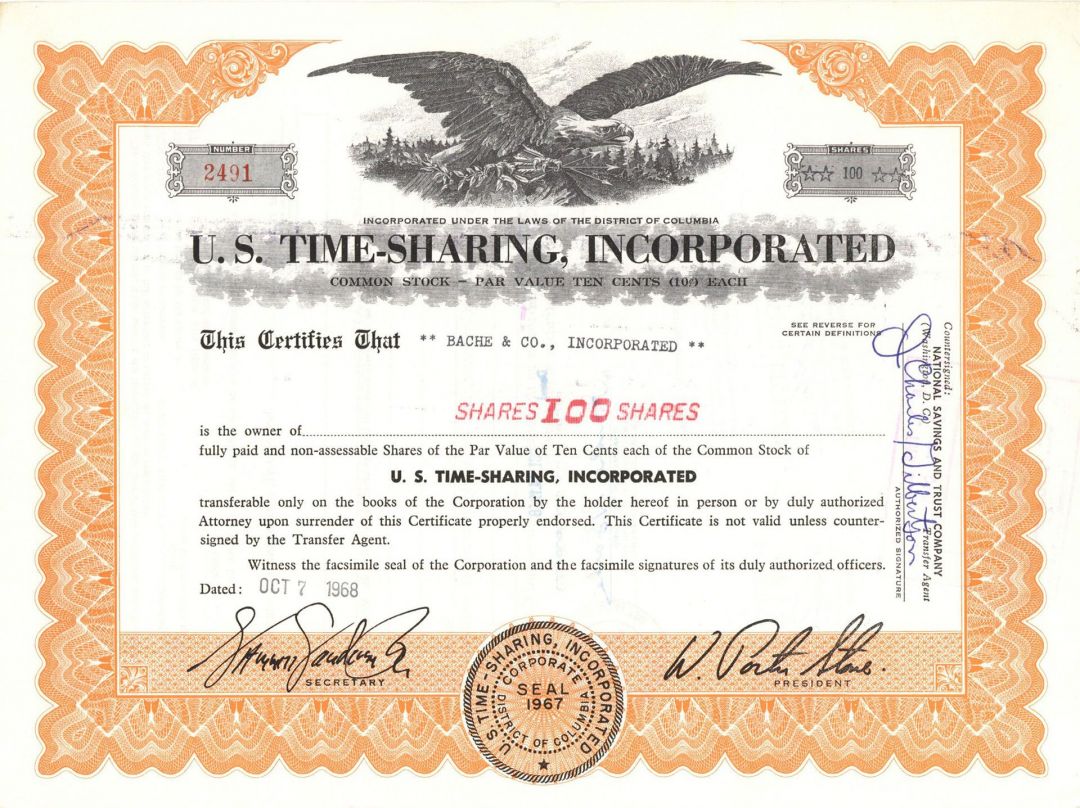U. S. Time-Sharing, Inc. - dated 1968-1973 Computer-Related Stock Certificate - District of Columbia
Inv# GS6509 StockStock with bright orange border! In the 1960s, several companies started providing time-sharing services as service bureaus. Early systems used Teletype Model 33 KSR or ASR or Teletype Model 35 KSR or ASR machines in ASCII environments, and IBM Selectric typewriter-based terminals (especially the IBM 2741) with two different seven-bit codes. They would connect to the central computer by dial-up Bell 103A modem or acoustically coupled modems operating at 10–15 characters per second. Later terminals and modems supported 30–120 characters per second. The time-sharing system would provide a complete operating environment, including a variety of programming language processors, various software packages, file storage, bulk printing, and off-line storage. Users were charged rent for the terminal, a charge for hours of connect time, a charge for seconds of CPU time, and a charge for kilobyte-months of disk storage.
Common systems used for time-sharing included the SDS 940, the PDP-10, the IBM 360, and the GE-600 series. Companies providing this service included GE's GEISCO, the IBM subsidiary The Service Bureau Corporation, Tymshare (founded in 1966), National CSS (founded in 1967 and bought by Dun & Bradstreet in 1979), Dial Data (bought by Tymshare in 1968), AL/COM, Bolt, Beranek, and Newman (BBN) and Time Sharing Ltd. in the UK. By 1968, there were 32 such service bureaus serving the US National Institutes of Health (NIH) alone. The Auerbach Guide to Timesharing (1973) lists 125 different timesharing services using equipment from Burroughs, CDC, DEC, HP, Honeywell, IBM, RCA, Univac, and XDS.
In 1975, acting president of Prime Computer Ben F. Robelen told stockholders that "The biggest end-user market currently is time-sharing." For DEC, for a while the second largest computer company (after IBM), this was also true: Their PDP-10 and IBM's 360/67 were widely used by commercial timesharing services such as CompuServe, On-Line Systems, Inc. (OLS), Rapidata and Time Sharing Ltd. The advent of the personal computer marked the beginning of the decline of time-sharing. The economics were such that computer time went from being an expensive resource that had to be shared to being so cheap that computers could be left to sit idle for long periods in order to be available as needed. Read more at https://en.wikipedia.org/wiki/Time-sharing
A stock certificate is issued by businesses, usually companies. A stock is part of the permanent finance of a business. Normally, they are never repaid, and the investor can recover his/her money only by selling to another investor. Most stocks, or also called shares, earn dividends, at the business's discretion, depending on how well it has traded. A stockholder or shareholder is a part-owner of the business that issued the stock certificates.










Ebay ID: labarre_galleries